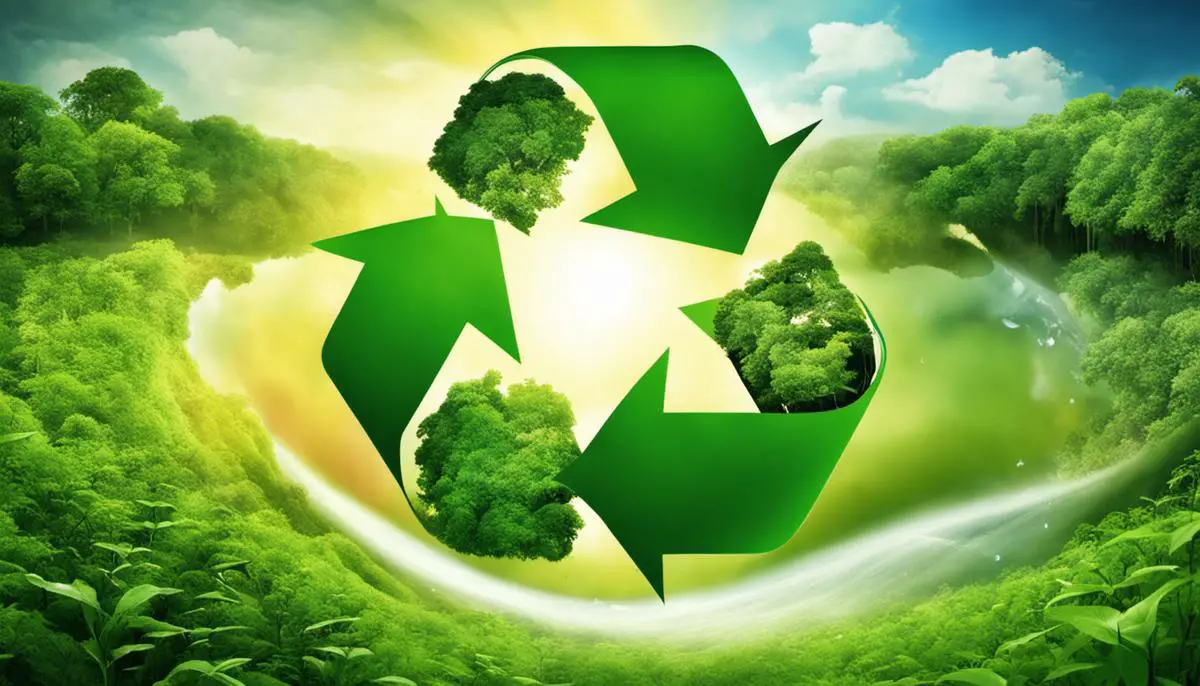What is environmental sustainability? What are its principles and goals? How can science and technology help achieve environmental sustainability? This article explains this important concept and provides 8 case studies to illustrate how it is applied in reality.
Understanding the context and importance of environmental sustainability is crucial in today’s world. As inhabitants of Earth, we hold a fiduciary duty to safeguard and perpetuate its resources, ensuring a prosperous future for generations that follow.
This piece takes a deep dive into the intricacies of environmental sustainability, elucidating its principles, its goals, and its role in our socio-environmental systems. We will explore the application of science and technology in enhancing sustainable practices and provide a robust purview of real-world cases demonstrating the effective implementation of these practices.
Join me as we journey towards a better understanding of our responsibilities to the Earth and to each other in the quest for sustainability.
Table of Contents
Defining Environmental Sustainability
Environmental Sustainability: A Quintessential Facet of Contemporary Society
In the realm of environmental conservation and management, the term ‘environmental sustainability’ is not just a mere expression, it carries a profound significance. It refers to responsible interaction with the environment, maintaining the integrity of its balance and biodiversity, and ensuring its health for future generations.
The importance of this subject in today’s society cannot be underestimated amid heightened awareness and escalating concerns over our planet’s welfare.
Environmental sustainability refers to responsible interaction with the environment, maintaining the integrity of its balance and biodiversity, and ensuring its health for future generations.
Within the context of environmental sustainability, it’s pertinent to understand the principle of sustainable development. Established by the United Nations in 1987, it calls for ‘meeting the needs of the present without compromising the ability of future generations to meet their own needs.’
Beyond the simplistic definition, it’s a call for an intelligent, considerate pattern of resource consumption and environmental management, extending from individual behaviors to global policies.
Sustainability is often framed within three pillars: 1) the environment, 2) the economy, and 3) society. These pillars outline the need for a balanced approach to consuming and conserving resources, maintaining ecological health, fostering economic prosperity, and improving quality of life—the concept of a ‘sustainable society.’
So why precisely is environmental sustainability so crucial in today’s society?
One simple rationale dominates—it is an existential necessity. Our natural resources are finite.
Human activities, such as deforestation, overfishing, and excessive carbon dioxide emissions, have led to environmental degradation, disrupting the delicate balance of our ecosystem. Without ensuring environmental sustainability, we jeopardize not only ecological stability but also our survival, as our lives are intrinsically tied to the environment.
Climate change illuminates this reality. Rising global temperatures, changing weather patterns, increased frequency and intensity of natural disasters—all are clear indicators of a distressed planet.
Not managing our resources sustainably has led to carbon dioxide concentration levels that invite unforgiving environmental consequences, attesting to the urgency of sustainable environmental practices.
On the same line, biodiversity loss is another pressing concern. Our planet’s ecosystems are elegantly interconnected; any disintegration of one species can drastically affect the functioning of another and potentially lead to ecological collapse.
Environmental sustainability practices are paramount in maintaining diverse habitats, ensuring the survival of all species and the balance of ecological systems.
In conclusion, environmental sustainability is a complex and multi-faceted issue that commands serious attention in today’s society. It is not just an environmental responsibility but an existential one.
Recognizing the interconnectedness of our economic, social, and environmental systems is critical to weave sustainability into the fabric of societies universally. By implementing sustainable patterns in our daily lives, from individual consumption to national policies, we hold the potential to affect significant change for a sustainable and vibrant future.
As stewards of this planet, the responsibility lies equally upon all inhabitants—continuing to learn, create, innovate, and act for the environmental sustainability imperative is the grand challenge and opportunity of our time.

3 Principles of Environmental Sustainability
A launch into the next locus of our discourse on environmental sustainability requires a look into the pivotal principles and end goals that shape the discipline.
Principle 1: Preserving the Natural Equilibrium
Foremost is the principle of preserving the natural equilibrium and carrying capacity of our planet. This principle posits that careful management of resources supports the long-term health of the Earth’s ecosystems, subsequently fostering the perpetuity of human and non-human species alike.
Further, this principle echoes the ethos that all species are endowed with the right to exist and thrive within their natural habitat.
Principle 2: Equality and Inclusivity of Sustainability Strategies
Another cardinal principle underscores the pivotal role of equality and inclusivity in shaping our sustainability strategies. This spectrum of thought considers the different socio-economic realities of people and regions globally, asserting that environmental sustainability should cater to all sections of society, regardless of their economic standing.
Consequently, environmental justice advocates for equitable distribution of resources, confirming that no community shoulders an excessive share of environmental catastrophes owing to industrial operations or waste disposal. Fairness on benefits to be gained is emphasized.
Principle 3: Principle of Resilience
Building upon these essentials is the principle of resilience, addressing the capacity of a system, community, or society to absorb disturbance and reorganize while undergoing change preserving essentially the same function, structure, identity, and feedbacks. Resilience is a critical component of sustainability since it allows systems to absorb shocks while maintaining their overall functionality.
3 Goals of Environmental Sustainability
With the aforementioned guiding principles, a scaffold for environmental sustainability is erected.
However, to survey an edifice so complex, one must be cognizant of its peaks – the end goals. These provide benchmarks for measuring our progress towards sustainability, albeit acknowledging that these targets are constantly shifting with the evolution of scientific understanding and societal values.
Goal 1: A Zero Waste Society
One chief goal is the realization of a zero-waste society, where resources are reused and recycled, mimicking the cyclical flow of nutrients in an ecosystem and thereby maintaining ecological balance.
Goal 2: Transition to Renewable Sources of Energy
Another monumental goal is the transition to renewable sources of energy. By harnessing power from the sun, wind, water, and earth, we can mitigate our dependence on fossil fuels, thereby curtailing greenhouse gas emissions and slowing the progress of climate change.
Goal 3: Shift Towards Sustainable Living
Perhaps the most ambitious yet imperative goal in environmental sustainability is arousing a global cognitive shift towards sustainable living. Ingraining sustainability in the ethos of every individual cultivates a deeper understanding and respect for the interconnectedness of all life forms. Only then, can the collective human species function as harmonious components of the biosphere and not as disruptive agents.
In conclusion, the journey towards sustainability is neither a straightforward nor a short-term endeavor. It requires diligence, dedication, and an unwavering commitment to transform societal norms and industrial practices. Realizing these principles and goals, though formidable, stand as the lodestar that guides our pursuit of a sustainable future.

The Role of Science and Technology in Environmental Sustainability
As we proceed further into the 21st century, advancements in science and technology unveil greater depths of understanding in the field of environmental sustainability, playing a crucial role in addressing the challenges faced by humanity and the earth’s biosphere.
1. Renewable Energy Technologies
Transformative technological innovations now exist that support environmental sustainability at various scales. Renewable energy technologies, for instance, substantially reduce reliance on finite fossil resources while curbing greenhouse gas emissions.
Solar, wind, geothermal, and bioenergy technologies are continually being refined for increased efficacy and affordability. Additionally, energy storage technologies, such as advanced batteries and fuel cells, ensure consistent energy supply while mitigating the dilemmas of intermittent renewable energy sources.
2. Biotechnology
By promoting resource-efficiency, clean technologies champion sustainable development. Biotechnology plays a vital role in the creation of biodegradable materials, reducing waste accumulation and promoting the cyclical aspect of natural ecosystems.
Furthermore, advancements in water purification and desalination technologies present implications for water-conservation, particularly in water-stressed regions of the globe.
3. Bioinformatics and Genomics
Scientific research has elucidated the impacts of human activities on biodiversity and ecosystem health, further necessitating the pursuit of sustainable practices. The bioinformatics tools and genomic studies, in particular, are helping to understand and conserve biodiversity. Techniques include sophisticated biomonitoring systems that strive to understand species interactions and ecological dynamics promoting conservation strategies.
4. Information and Communication Technology
Accompanying these tangible technological solutions is Information and Communication Technology (ICT). Innovations such as Artificial Intelligence (AI), Internet of Things (IoT), and Big Data Analytics provide potent platforms for environmental management by enhancing our capacity to collect, process, and analyze environmental data. These tools enable predictive modeling and more accurate strategies for resource management, as well as data-driven policy development and enforcement.
5. Precision Farming Techniques
In the agricultural sector, precision farming techniques, backed by satellite imagery and drone technologies, mitigates overutilization of resources and thus desertification, while boosting yield in a sustainable manner. Moreover, genetic modification technology proposes crops that are drought and pest-resistant, hence reducing the use of harmful pesticides and promoting resilience in food systems amidst climate change.
6. Green Architecture and Construction Technologies
The progression towards sustainable urbanization benefits vastly from the advancements in science and technology. Green architecture and construction technologies foster energy-efficient, self-sustaining buildings that lessen the ecological footprints of urban areas.

7. Transport Innovations
Furthermore, innovations in transport, like electric and self-driving vehicles, are diminishing carbon emissions in cities objectively promoting clean air and human health. As will be discussed in the next section, there are well known companies engaging in research and development that promote fuel efficiency and reduce carbon emissions.
In conclusion, as scientific knowledge expands to fathom the intricacies of our environment, and technology persists in its rapid evolution, there exists a hopeful vision for the future of environmental sustainability. For this relationship between science, technology, and sustainability is symbiotic, leading humanity towards a necessary equilibrium with the planet we call home.
The creative and adaptive abilities of mankind through science and technology have never been more pertinent to write a new narrative—a narrative of a sustainable future—free from the dominating discourse of environmental degradation.
Far from a utopian dream, this is our achievable reality, guided by the beacon of science and technology.
The Practice of Environmental Sustainability: Real-world Cases
Building on this foundation, it becomes necessary to explore tangible examples and case studies that demonstrate successful implementation of environmental sustainability at various scales – from local to global.
1. Integrating Urban Planning and Public Transportation Systems: The Case of Curitiba, Brazil
A classic case of a city embodying environmental ethos is Curitiba, Brazil, lauded for integrating urban planning and public transportation systems to reduce carbon emissions. The city introduced a Bus Rapid Transit system that led to a 30% decrease in car trips, alleviating noise pollution and greenhouse gas emissions.
2. Incorporating Renewable Energy into City Infrastructure
Copenhagen, Denmark presents an excellent instance of incorporating renewable energy sources into the city’s infrastructure. The city is on track to become the world’s first carbon-neutral capital by 2025, primarily through the use of wind power.
3. Organic Farming Practices in India
In the realm of agriculture, the approach of Sikkim, India, stands as an example. The state pioneered organic farming practices and has become the first fully organic state in India, successfully proving the feasibility of sustainable farming at a large-scale, with hope-transpiring implications for agriculture globally.
4. Toyota Motor Corporation’s Hybrid Systems
Another successful case study is that of Toyota Motor Corporation’s Hybrid Systems, where sustainability is knitted into the business model itself. Toyota’s hybrid cars showcase the integration of innovative technology with sustainable practices, curbing carbon emissions while emphasizing fuel efficiency.
5. Green Commercial Buildings
Within the realm of construction, the Bullitt Center in Seattle, Washington, USA, is considered one of the greenest commercial buildings in the world. It generates its own energy through a rooftop solar array, implements a rainwater-to-potable water system, and treats its own waste.
6. Use of IoT Devices and Services to Manage Energy Use
The advancement of information technology is evident in how the Internet of Things (IoT) is being used to manage energy consumption in buildings. A crucial case study would be EnOcean, a company that uses IoT devices and services to manage energy use in buildings efficiently.
7. Costa Rica: A Carbon-Neutral Nation
At a larger scale, the transition of Costa Rica towards a carbon-neutral nation is certainly commendable. Over 98% of its power generation comes from renewable sources, affirming the feasibility of a nationwide transition towards environmental sustainability.
8. NEWater Program in Singapore
Equally noteworthy is Singapore’s initiative to deal with water scarcity issues. The NEWater program recycles wastewater into high-grade reclaimed water, which now meets up to 40% of the nation’s water demand, anticipating it to cover 55% by 2060.
These varying case studies reflect a shared understanding that habitability of our planet for future generations relies on concerted efforts to promote environmental sustainability today. Crucially, they highlight that the principles and technologies exist, and when appropriately applied, sustainability can transform societies and economies at all scales. The future lies in the broad adoption and continuous innovation of such sustainable practices and technological solutions.
The charge is clear: we must seize the opportunity to redefine the trajectory of our planet, relentlessly pursuing sustainability in every action and decision today, for securing a balanced, equitable, and thriving ecosystem tomorrow.

Environmental sustainability is not just a lofty concept but a real-world necessity, supported by principles, goals, and the power of science and technology. The remarkable case studies spread across the globe confirm the effectiveness of sustainable practices in various industrial sectors.
The sustainable solutions highlighted herein emphasize that not only is enacting such practices possible, but they can also indeed thrive in the right conditions. Let our exploration of this topic serve as a pathway for committed action towards a healthier and more sustainable world, creating a legacy of equilibrium and abundance for future generations.

